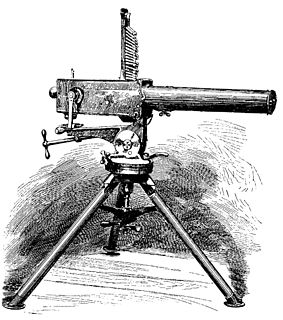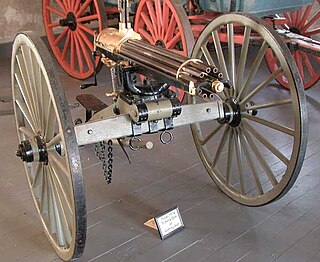 W
WThe Agar gun was an early rapid fire machine gun developed during the US Civil War. The weapon was nicknamed the Coffee Mill Gun, and was also called the Union Repeating Gun.
 W
WThe Bailey Machine Gun was a rapid-fire weapon developed in the late 19th century. It was a multiple barrel weapon similar to the much more commonly known Gatling gun, and was the first weapon of this type to be belt-fed. Although commonly referred to as the Bailey Machine Gun, it is technically not a machine gun since it is externally powered using a hand crank. However, rapid-fire weapons of this type are commonly referred to as machine guns, even though this usage of the term is technically incorrect.
 W
WThe Fittipaldi machine gun is a recoil-operated machine gun designed by Rafael Fittipaldi and patented as USPTO number 1,099,245, of June 9, 1914.
 W
WThe Gardner gun was an early type of mechanical machine gun. It had one, two or five barrels, was fed from a vertical magazine or hopper and was operated by a crank. When the crank was turned, a feed arm positioned a cartridge in the breech, the bolt closed and the weapon fired. Turning the crank further opened the breechblock and extracted the spent case.
 W
WThe Gatling gun is a rapid-firing multiple-barrel firearm invented in 1861 by Richard Jordan Gatling. It is an early machine gun and a forerunner of the modern electric motor-driven rotary guns and rotary cannons.
 W
WThe Colt–Browning M1895, nicknamed "potato digger" because of its unusual operating mechanism, is an air-cooled, belt-fed, gas-operated machine gun that fires from a closed bolt with a cyclic rate of 450 rounds per minute. Based on a John Browning and Matthew S. Browning design dating to 1889, it was the first successful gas-operated machine gun to enter service.
 W
WThe Maxim gun was a weapon invented by British-American inventor Sir Hiram Stevens Maxim in 1884: it was the first recoil-operated machine gun in production. It has been termed "the weapon most associated with imperial conquest" by British historian Martin Gilbert, and was heavily used by colonial powers during the Scramble for Africa during the era of New Imperialism.
 W
WThe Maschinengewehr 08, or MG 08, was the German Army's standard machine gun in World War I and is an adaptation of Hiram S. Maxim's original 1884 Maxim gun. It was produced in a number of variants during the war. The MG 08 served during World War II as a heavy machine gun in many German infantry divisions, although by the end of the war it had mostly been relegated to second-rate fortress units.
 W
WA mitrailleuse is a type of volley gun with barrels of rifle calibre that can fire either rounds at once or in rapid succession. The earliest true mitrailleuse was invented in 1851 by Belgian Army captain Fafschamps, ten years before the advent of the Gatling gun. It was followed by the Belgian Montigny mitrailleuse in 1863. Then the French 25 barrel "Canon à Balles", better known as the Reffye mitrailleuse, was adopted in great secrecy in 1866. It became the first rapid-firing weapon deployed as standard equipment by any army in a major conflict when it was used during the Franco-Prussian War of 1870–71.
 W
WThe Montigny mitrailleuse was an early type of crank-operated machine-gun developed by the Belgian gun works of Joseph Montigny between 1859 and 1870. It was an improved version of the "Mitrailleuse", invented by Belgian Captain Fafschamps in 1851 which was a fixed 50-barrelled volley gun.
 W
WThe Nordenfelt gun was a multiple barrel organ gun that had a row of up to twelve barrels. It was fired by pulling a lever back and forth and ammunition was gravity fed through chutes for each barrel. It was produced in a number of different calibres from rifle up to 25 mm (1 inch). Larger calibres were also used, but for these calibres the design simply permitted rapid manual loading rather than true automatic fire. This article covers the anti-personnel rifle-calibre gun.
 W
WBrigadier General John Henry Parker aka "Gatling Gun Parker" was a brigadier general in the United States Army. He is best known for his role as the commander of the Gatling Gun Detachment of the U.S. Army's Fifth Army Corps in Cuba during the Santiago campaign in the Spanish–American War.
 W
WThe Perino Model 1908 was an early machine gun of Italian origin designed earlier in 1901 by Giuseppe Perino, an engineer. Perino's design apparently was the first Italian-designed machine gun, and in its original configuration weighed in at a heavy 27 kilograms (60 lb), which made it largely unsuitable to field utilization and apt only for fortifications; a lightened 1910 version brought the weight down to 15 kilograms (33 lb). The gun was nonetheless adopted by the Regio Esercito and saw some use alongside the Fiat-Revelli Modello 14 and the Maxim guns. It had a unique feed mechanism, with a hopper on the side of the gun filled with up to five twenty-round clips rather than being belt fed. This allowed the loader to constantly keep the gun at maximum capacity, meaning the gun crew never had to stop to reload.
 W
WJames Puckle (1667–1724) was an English inventor, lawyer and writer from London chiefly remembered for his invention of the Defence Gun, better known as the Puckle gun, a multi-shot gun mounted on a stand capable of firing up to nine rounds per minute. The Puckle gun is one of the first weapons referred to as a machine gun and resembles a large revolver.
 W
WThe Ripley Machine Gun was a volley gun, an early precursor of the machine gun, which was patented in 1861 by Ezra Ripley. Although it is likely that it was never actually produced, it demonstrated a number of basic concepts that were employed in the design of the Gatling Gun that was patented the following year.
 W
WThe Salvator-Dormus M1893 also known as Skoda M1893 was a heavy machine gun of Austro-Hungarian origin. It was patented by Archduke Karl Salvator of Austria and Count George von Dormus and was manufactured by Skoda Works Plzeň. The Salvator-Dormus was chambered in the 8x50mmR round fed from an overhead magazine and was water-cooled with an oil lubrication device. There was also a pendulum adjustment in the trigger mechanism that allowed the operator to select the cyclic rate of fire, anywhere from 180 to 250 rounds per minute. The M1893 was cheaper than the Maxim gun but was gradually replaced by the Schwarzlose MG M.07/12.
 W
WA volley gun is a gun with multiple single-shot barrels that shoot projectiles in volley fire, either simultaneously or in succession. Although capable of unleashing intense firepower, volley guns differ from modern machine guns in that they lack autoloading and automatic fire mechanisms, and therefore their volume of fire is limited by the number of barrels bundled together.